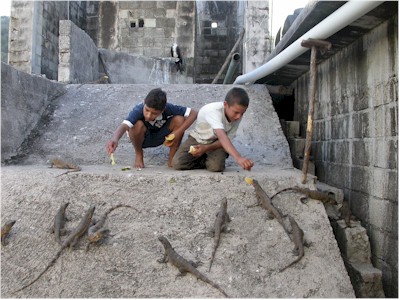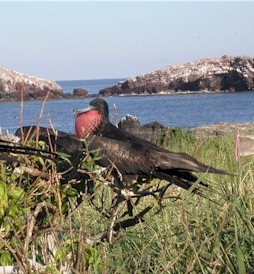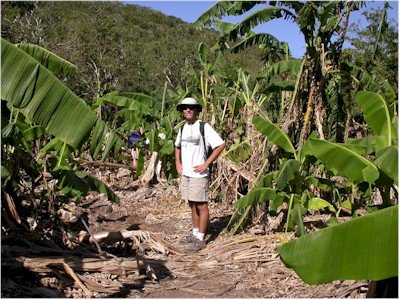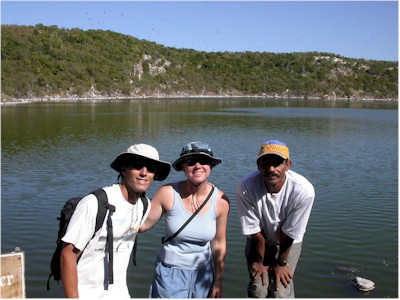
The Sea calm as a kitten
 |
|
The Sea calm as a kitten |
We sailed southeastward from Los Frailes towards Isla Isabel, a small island nature preserve near the mainland Mexico coast, 200 miles from Los Frailes. With our friends on Rouser just ahead we had a wonderful sail under a clear warm blue sky, the wind about 10 knots from the north, until around 1800 that evening. When our speed dropped to under 2 knots that evening and the sea turned to pure glass, we sadly started up the loud and hot diesel to push us along.
At 0900 the next morning we were still motoring, the sea still as smooth as a pond, not a ripple. Despite the roar of the prop, several schools of dolphins came by to check us out that morning. We tried to get some photos of the charming mammals as they chased each other around the boat, but as usual the photos only turned out to be great shots of bubbles.
At 1600, the boat scorching hot from the blazing sun and amazing heat radiating from the chugging diesel, we stopped alongside Rouser in the middle of the still glassy sea deciding that it would be great to go for a swim. When we stopped however we saw that the water was filled with large and small jellyfish; those along with the thought of the sharks that could be lurking in the great depths caused us to reconsider that idea. We did enjoy drifting about for about an hour enjoying the break from the noisy throbbing diesel.
 |
|
Feeding Isabel iguanas |
When we turned the diesel on and tried to put it in forward gear once again, we noticed some slippage into forward gear just like what had happened a few months earlier when we had Westerbeke replace the HBW-50 transmission. We couldn't believe that the new transmission could be going out too and tried to put it in the backs of our minds as we continued the long motor to Isla Isabel.
After dinner that evening we put on some mellow techno-house type music while we sipped some glasses of wine (we told you the sea was calm!), when an amazing group of dolphins must have heard the beats and swam on the bow of the boat for at least 45 minutes. During this time both of us were able to lean over the bow and watch them closely, the creatures illuminated in almost invisible water by the bright full moonlight that evening. We watched them in awe as they crowded each other at the bow, nuzzling each other out of the way for what must have been the primo bow wave spot. They would actually roll over a bit and watch us watch them with their bright eyes, then jump a bit out of the water and spray us with water! Michael was able to hang his arm over the side of the boat and one of the dolphins jumped and let him touch its fin. It was simply a magical moonlit experience watching these marvelous beings, knowing that they were enjoying interacting with us as well.
|
Mama Booby and Baby Booby |
After motoring through the windless night we arrived with Rouser at Isla Isabel at 0800 in the morning and gingerly set our hook off the dramatic volcanic rocks of the island. As promised, the island was absolutely covered with birds; hundreds -- thousands -- of large black and white frigate birds and booby birds were constantly soaring overhead. The anchorage is full of boulders with just a few sandy patches here and there. We missed a sandy patch of course and got the CQR anchor wedged in between some rocks. This anchorage is infamous for "anchor-eating" and we were a bit nervous about the situation but we seemed to be set in well, plus we had put a bouy on our anchor. Rouser dropped their anchor, then Eric dove in to check on it and found it resting on a Volkswagen sized boulder! So they reset it in a more friendly area.
Michael stayed behind on Pelican to keep an eye on both boats in the sketchy anchorage while Sara went ashore to explore the fascinating nature preserve with the Rousers. Ashore we found a bunch of friendly fishermen camped out on shore, resting in the shade on their hammocks. Farther on down the beach we found an old cement building that had few walls but a bunch of camping tents set up in a large open area under the roof. We soon met the biology research students from the University of Guadalajara that were stationed there for a month at a time, and they showed us around their living and study areas set up in this building and had us sign their guestbook. (We also verified that the island is named "Isabel" not "Isabella" as is reported on many of the charts and guidebooks we have on board.)
 |
|
A studly frigate bird |
There was a lone frigate bird sitting on a perch near the yard and we were told that this bird had a broken wing and was being rehabilitated. Some small boys were nearby and they showed us some oranges they had; they started breaking the fruit into little pieces and were suddenly surrounded by hungry brown iguanas! We all laughed at the funny lizards darting around for the food. Isla Isabel has some wonderful inhabitants, both human and creature.
We hiked up the lighthouse hill behind the research building, which was where the booby birds nested. Along the way we passed many many frigate bird nests, right along the trail at eye level. The birds were in their courting phase; the males had their red necks expanded like balloons to attract the females. The island was simply amazing how it was absolutely covered with birds -- nesting, flying, feeding, they were literally all around us! They seemed to have no fear at all of humans as we could walk right by the nests (you had to to walk anywhere on the island!) without much notice from them.
|
Overlooking dramatic Isla Isabel |
Once we started climbing the hill we came upon the booby nests. The birds with brightly colored blue or green or yellow feet and matching beaks would be sitting right on the rocks, maybe with a small pile of grass and twigs. Many of the females had young boobies laying beside them -- they were adorable white fuzzy baby booby birds!
The view from the top of the hill was amazing -- we could see the whole island, very dramatic red volcanic sculptured rock formations, bright green foliage and peaceful-looking crater lake on the other side of the small island. Waves pounded the island's northwestern shores. Best of all, the entire top of the lighthouse hill was covered with booby nests. We watched surrounded by them in quiet amazement.
Back on the beach, we walked by the fish camp and started on the short trail to crater lake. Along the way, we met one of the local fishermen, Gabino, who was showing some other visitors the trail to the lake. We joined in and had a great time hearing directly from him some stories from the island.
 |
|
Hiking in the Isabel tropics |
The hike was fascinating too -- it was the most foliage and the tallest trees we'd seen since northern California, refreshing after the barren Baja coast. The plants were very tropical with huge tall leaves and even some pineapples growing amongst them. Crater lake was pretty, although Gabino said was acidic and not good for swimming. With the greenish-tinged water, we believed him.
That night we didn't sleep so well as all during the night we heard the constant grinding of our chain against the boulders. We thought for sure the chain would be so entangled that we'd never get it up when we left. Also the anchorage is not protected from the ocean swells very well so we rocked back and forth, back and forth all night long.
In the morning, Michael got to go exploring ashore finally with Sara and Angela. Gabino met us on the beach and hiked with us again to the top of the lighthouse hill, over to crater lake, and this time over the island to the beach on the north side. It was a beautiful walk through dry woods, grasslands, tropical bushes. We had a great time practicing our Spanish with Gabino, as he told us all sorts of interesting information about the plants, birds and animals of the island. He was quite the budding biologist! When we arrived back at the anchorage, Gabino gave us each a lovely red snapper-type fish to take back to the boat.
 |
|
Lago Crater with our guide, Gabino |
As we knew that we would not get much sleep that night due to the noisy grinding of our anchor chain on the underwater boulders and rolly conditions, we decided to leave that evening and sail overnight the 80 miles to La Cruz in Banderas Bay, most famous for Puerto Vallarta. Leaving the island just after sunset we had a nice downwind sail with the genoa. Sadly again the wind died around midnight so we took down the thrashing sail and we motored the rest of the way around Punta Mita and into Banderas Bay.
During Michael's watch around daybreak he threw out our trolling line. A short while later he was shocked to see a booby bird trailing behind the boat. When he pulled in the line, he discovered the booby had grabbed our fishing lure, gotten caught and had died. A very sad booby bird encounter....
That morning, we anchored off the small town of La Cruz, happy to be on the steamy hot mainland coast at last. It was to be our first night of many in Banderas Bay.